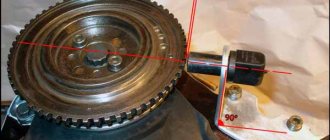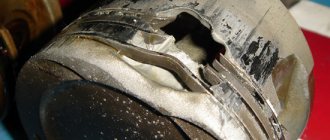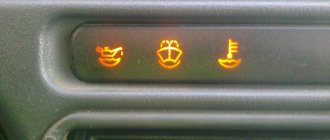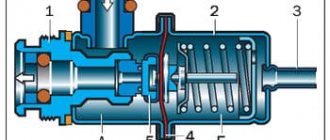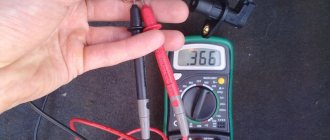Small sensors in a car's electronic system play a vital role. If some of them malfunction, it is not at all possible to start the engine, but even if the motor runs, its main technical indicators will show a significant difference in the nominal values. A malfunction of the VAZ 2112 16 valve crankshaft sensor can significantly reduce the “quality of life” of the internal combustion engine. More details about the main symptoms of a malfunction, methods of diagnosis and repair in a garage will be discussed in detail in this article.
What is the crankshaft sensor for?
The crankshaft sensor is the most important part of the electronic ignition system of the VAZ 2112 car. With the help of DPKV it is possible to control and adjust the following systems:
- Timing of fuel injection in injectors.
- Change of valve timing.
- Ignition of the fuel mixture.
- Absorption of fuel vapors.
In addition, the sensor allows you to accurately determine the position of the first and fourth cylinders and engine speed. This data is also very important for ensuring the correct operation of many vehicle functions and systems.
The performance of the entire vehicle ignition system depends on the condition of this part, as well as its correct settings, so if there is a suspicion that unstable engine operation is caused by a malfunction of this part, then diagnostic operations should be immediately performed to accurately determine the breakdown.
What is a crankshaft position sensor on a vase
The induction type crankshaft position sensor is installed next to a special disk located in conjunction with the crankshaft drive pulley. The special disk is called a reference or master disk. Together with it, it ensures angular synchronization of the operation of the control unit. Skipping two teeth out of 60 on the disk allows the system to determine the TDC of the 1st or 4th cylinder. The 19th tooth after skipping should face the DPKV rod, and the mark on the camshaft should be against the bent reflector bracket. The gap between the sensor and the top of the disc tooth is in the range of 0.8-1.0 mm. The sensor winding resistance is 880-900 Ohms. To reduce noise levels, the crankshaft sensor conductor is shielded.
After turning on the ignition, the control program of the unit is in the waiting mode for the synchronization pulse signal from the crankshaft position sensor. When the crankshaft rotates, the sync pulse signal arrives instantly to the control unit, which, in accordance with their frequency, switches the electrical circuit of the injectors and the ignition coil channels to ground.
The control unit program algorithm works on the principle of reading 58 teeth passing by the magnetic core of the DPKV, skipping two. The skipping of two teeth is a reference mark for determining the piston of the first (fourth) cylinder in the top dead center position, from which the unit analyzes and distributes the switching signals that control the opening of the injectors and the spark on the spark plugs over the engine operating strokes.
The control unit detects a short-term failure in the synchronization system and tries to resynchronize the control process. If it is impossible to restore the synchronization mode (lack of contact on the DPKV connector, cable break, mechanical damage or broken master disk), the system issues an error signal to the instrument panel, lighting the Check Engine warning lamp. The engine will stall and it will be impossible to start it.
The crankshaft position sensor is a reliable device and rarely fails, but sometimes malfunctions occur due to the inattentive or negligent attitude of specialists servicing the engine.
For example, a VAZ-2112 has a 21124 engine (16 valves where the DPKV cable is located very close to the exhaust manifold) and the problem usually arises after a repair, when the chip on the cable is not secured to the bracket. When the cable comes into contact with a hot pipe, it melts, destroying the connection circuit and the car stalls.
Another example would be a poorly manufactured drive disc, the rubber coupling of which may rotate along the internal connection.
The electronic control unit, receiving a single signal from the DPKV, determines the position relative to the crankshaft at each moment of time, calculating its rotation frequency and angular velocity.
Based on sinusoidal signals issued by the crankshaft position sensor, a wide range of problems are solved:
- Determination at a given time of the position of the piston of the first (or fourth) cylinder.
- Control of fuel injection timing and injector open duration.
- Ignition system control.
- Control of variable valve timing system;
- Control of the fuel vapor absorption system;
- Ensuring the operation of other additional systems related to engine speed (for example, electric power steering).
Thus, the DPKV ensures the functioning of the power unit, determining with high accuracy the operation of its two main systems - ignition and fuel injection.
Before purchasing a DPKV to replace it, you need to clarify the type of device installed on the engine.
Principle of operation
The design of the DPKV is very simple. This part is an electromagnet that generates pulses as a result of the metal teeth of a special disk mounted on the crankshaft passing past its core. More precisely, an electrical signal is generated at the moment when there are no protrusions on the gear wheel.
To ensure the stability of pulse formation, it is important to correctly set the gap between the DPKV core and the gear wheel. The optimal value of this parameter for the VAZ 2112 car is 0.8 - 1.0 mm.
Symptoms of a problem
Most of the manifestations of a malfunction of the crankshaft sensor of a VAZ 2112 16 valve car are not specific. If the engine does not start at all, then, first of all, you should check the presence of gasoline in the tank and the integrity of the armored wire, through which high voltage is transmitted from the step-up transformer to the ignition distributor.
When the engine is running, the following signs of DPKV malfunction may be observed:
- The engine starts after cranking the crankshaft for several seconds.
- “Floating” idle speed.
- A sharp decrease in engine power.
- Increased fuel consumption.
For VAZ 2112 engines with 16 valves, where detonation is possible during operation, DPKV diagnostics must also be carried out. If this part malfunctions, the electrical signal may be sent to the ECU with a delay, which can cause instability in the operation of the internal combustion engine, accompanied by explosive combustion of the fuel mixture.
VAZ 2112: crankshaft sensor - malfunctions and replacement
Crankshaft sensor VAZ 2112
In the design of the VAZ 2112 engine, the crankshaft position sensor is an electromagnetic sensor through which the operation of the ignition system and fuel injectors is synchronized in the fuel injection system. Therefore, DPKV is actually the main one; without it, the operation of the entire fuel injection system becomes impossible. When a crankshaft sensor malfunction occurs on a VAZ 2112, this inevitably leads to unstable engine operation. It is very easy to identify faults and replace the DPKV by reading our article.
Reasons for failure of the DPKV
In order to ensure the longest possible operation of the new part after replacing the sensor, you need to know about the reasons that most often cause failure of the DPKV.
This category of vehicle states and operating modes includes:
- Mechanical damage.
- Dirt, sand or metal shavings get inside.
- DPKV breakage due to crankshaft teeth.
- Short circuits in the car's electrical wiring.
In addition to the reasons listed, the sensor may not work due to manufacturing defects or errors during repair and installation operations.
Sensor overview
What the controller is responsible for: synchronizing the phases of fuel injection, supplying an electronic pulse to ignite the fuel in the cavity of the combustion chamber. The timeliness of supply of the combustible mixture to the cylinders depends on the accuracy of the measuring device.
The DPKV reacts to the passage of each of the crankshaft teeth mounted on the generator drive pulley. The angle of inclination of the teeth is 6°. All teeth are equally spaced.
The last two teeth are cut off to form a cavity. It is necessary to center the pulley at the top dead center (TDC) position.
Where is the controller located: on the oil pump cover in the engine compartment. Access to the equipment for carrying out maintenance from below, having previously dismantled the metal protection of the oil pan.
Signs of a faulty crankshaft sensor:
- The engine does not start;
- Starting the engine is difficult;
- Idle speed is unstable;
- Sudden drop in engine power;
- Detonation;
- Passive acceleration dynamics;
- Increased fuel consumption;
- Under light loads, systematic shifts to a lower range of gears.
These symptoms are signs of a number of other breakdowns. It is extremely important to conduct comprehensive diagnostics using digital equipment.
| Name / catalog item | Price in rubles |
| VAZ-2110-2112 AU000080 | From 350 – 400 |
| 402.3847 | From 350 – 400 |
| 191.3847 | From 350 – 400 |
| 2112-3847010-04 | From 350 – 400 |
| 2112-3847010 | From 350 – 400 |
| 476438 | From 350 – 400 |
| EMI 2112-3847010 (16 valves) | From 350 – 400 |
| ASTRO 402.3847 | From 350 – 400 |
| AUTOTRADE VAZ-2110-12 | From 350 – 400 |
Technical characteristics of DPKV:
- Winding resistance range: 570 – 750 Ohm;
- Winding inductance: 250 MHz;
- Minimum sensor voltage amplitude: 0.3V;
- Maximum sensor voltage amplitude: 225V;
- Dimensions: 30x45x69 mm;
- Weight: 52 grams.
Step-by-step instructions for self-diagnosis
To check the condition of the DPKV we need a multimeter. The measuring device is available to many car enthusiasts. If you don't have it, you can purchase it at any auto store. The price is affordable.
- From under the bottom of the car, disconnect the terminals from the sensor.
- We bring the limit switches to the contacts;
- Turn on the multimeter, set the position of the regulator to “resistance”;
- We carry out actual measurements;
- We compare the obtained data with standards. If the arrow tends to infinity, the controller is working. If it goes to “zero”, it’s a breakdown. Normally, readings should be 550-750 Ohms.
Depending on the diagnostic results, the technician makes a decision on the advisability of further operation of the equipment.
Causes of premature wear of the DPKV
- long-term operation without intermediate prevention;
- manufacturing defects;
- third-party mechanical damage;
- ingress of sand, dirt, metal shavings;
- sensor breakage due to crankshaft teeth;
- damage to the DPKV during repair work;
- short circuit in the on-board circuit.
Self-diagnosis
You can carry out a complete diagnosis of the VAZ 2112 internal combustion engine at a specialized car service station. The cost of such an operation can be several hundred rubles; in addition, you will need to cover a certain distance to the service in your own car, which is quite difficult in case of pronounced problems in the engine’s operation.
Considering the fact that the DPKV is a passive electrical device, the main characteristics of which can be easily measured using a multimeter or tester, it is absolutely not necessary to contact specialized workshops to carry out diagnostics.
Main parameters of DPKV VAZ 2112
Before you begin to independently determine the malfunction of the VAZ 2112 ignition system, it would be a good idea to familiarize yourself with the main parameters of the crankshaft sensor, which is standardly installed on cars of this brand. The main technical characteristics of the VAZ 2112 DPKV are:
- Winding resistance: 570–750 Ohms.
- Winding inductance: 540 mH.
By measuring these critical parameters, the integrity of the winding can be determined. Burnout of a thin conductor inside the coil is one of the most common causes of failure of this part, therefore
Checking with a multimeter
First of all, you need to decide where the DPKV is located. Considering the purpose of this part, it is easy to guess that it is located on the crankshaft or in close proximity to it. DPKV VAZ 2112 is located near the crankshaft pulley, through which torque is transmitted to the electric current generator.
The crankshaft position sensor can be checked using a multimeter or any other device that allows you to accurately determine the value of the winding resistance. The work is performed in the following sequence:
- Disconnect the sensor terminals.
- Turn on the measuring device and switch it to resistance measurement mode.
- Connect the multimeter probes to the DPKV contacts.
- Measures the resistance of the sensor winding.
If the device does not indicate the presence of a closed electrical circuit, this will mean that the internal winding has burned out. Normally, the resistance of the part should be in the range of 570 - 750 Ohms. Considering the fact that the sensor is located in a hard-to-reach place, it can first be dismantled, and only then can the measuring work be carried out.
Methods for troubleshooting
If you find at least one of the above symptoms of a malfunction, then first of all pay attention to whether the device is dirty and whether there is any mechanical damage on it. To do this, you must first remove the device. This is not difficult to do and all we need is a 10mm wrench.
- First of all, turn off the ignition.
- Find the crankshaft position sensor.
- Disconnect the connectors.
Disconnecting the wires - Using a wrench, unscrew the bolt securing the device.
Unscrew the bolt - Remove the crankshaft position sensor from the bracket.
We remove the DPKV
We carefully inspect for damage; if any are found, it is better to immediately go to the store for a new one.
You can check this device yourself; to do this, you just need to determine the resistance of the windings. The ohmmeter reading should be between 550-570 Ohms. If the readings are correct, then perhaps it's all in the wiring. Check all wires and connections one by one. Do not try to repair the crankshaft sensor on VAZ cars - it cannot be repaired.
Before installation, be sure to wipe the shrinkage area, it should be clean from dirt and dust. Next, install the shaft sensor and tighten the bolt. After connecting the wires, the work can be considered complete. As you can see, the whole procedure is quite simple. If you want to get more information, or do not understand where the shaft is located, then watch the video we offer.
Loading …
Replacing DPKV VAZ 2112 with your own hands
Having accurately determined the breakdown of this part, you can begin to replace the sensor yourself. To perform this operation you will need the following tools and materials:
- Set of wrenches and socket heads.
- New DPKV.
- Slotted screwdriver.
- Rags.
It is recommended to carry out work on replacing the DPKV in the following sequence:
- Place the car on a flat surface.
- Secure the machine with wheel chocks and apply the parking brake.
- Disconnect the negative terminal of the battery.
- Using a screwdriver, pry up the block with wires and disconnect it from the DPKV.
- Using a 10mm socket wrench, unscrew the bolt holding the sensor.
- Remove the DPKV.
After troubleshooting the seat, a new part is installed in the reverse order of removal. After completion of installation work, the functionality of the DPKV should be checked.
For this purpose, you need to start the engine, warm it up and drive the car for several kilometers under different loads on the internal combustion engine. If no abnormalities are found, then replacing the crankshaft sensor can be considered successful.
How to independently replace the crankshaft sensor on a VAZ 2112 car
Required materials and tools:
- key to “10”;
- head, knob;
- rags;
- additional lighting as needed;
- new DPKV;
- flat head screwdriver.
Regulations:
Signs of a malfunction of the crankshaft sensor on a VAZ 2114. AvtoVAZ trouble
- We place the car on the inspection channel, secure the wheels with wheel chocks, and squeeze the parking brake;
- from the end of the engine, in the area where the oil pump is located, use a screwdriver to pry up the block with terminals, remove it, and move it to the side;
- Unscrew the screw (to “10”) - the clamp from the sensor;
- remove the controller;
- We carry out troubleshooting of the seat, wipe it, clean it from residual dust and dirt;
- insert a new controller;
- screw it in and assemble the structure in reverse order.
DIY replacement completed.
Recommendations for servicing the controller
- strictly comply with the car manufacturer's regulations;
- do not violate the terms of technical inspection;
- buy and install mainly original parts;
- Carry out installation work yourself if you have sufficient experience.
The average service life of the DPKV is 70,000 km or more.
Tips and tricks
In the process of performing diagnostic and repair work, an inexperienced technician may make serious mistakes that will negatively affect both the performance of the part itself and other devices and assemblies of the machine. To protect yourself from such troubles, it is recommended to adhere to the following recommendations:
- When performing repair work, you should stop smoking. When removing the sensor, a certain amount of lubricating fluid may appear, which is a highly flammable substance.
- When measuring resistance, the multimeter must be switched to the appropriate operating mode. Some modes that can be used to determine this parameter of an electrical circuit are also not suitable. For example, when the toggle switch is set to a resistance measurement range of up to 200 Ohms, the nominal value of DPKV (500–700 Ohms) will be outside its limits, which will lead to false positive results in determining the malfunction of this part.
- If the DPKV fails due to severe contamination, then the new part may also not last very long. To significantly increase the service life of the DPKV, it is recommended to eliminate oil leaks, which can cover all parts within a short period of time. This film, like a magnet, attracts dust and dirt.
- You should only purchase a new part from a reputable dealer. Failure of the DPKV due to manufacturing defects is a fairly common reason if the sensor is purchased on specialized markets. An indirect sign of a low-quality spare part is its cost. Typically, counterfeit spare parts are sold 2-3 times cheaper compared to original products.
- When replacing a sensor, the wires must be properly connected to it. If this is not done, the connector may become separated from the contacts when driving on a bumpy road, which will lead to the cessation of impulses from the DPKV to the vehicle's ECU.
How to check the crankshaft sensor of a VAZ 2112 is described in detail in this article. If you fix the breakdown strictly according to the instructions, then even an inexperienced person can handle this work. If you have doubts about your own abilities, you should not risk the “health” of the car. The work of replacing the DPKV is carried out by many specialized service stations, is relatively inexpensive and does not require significant time expenditure.

